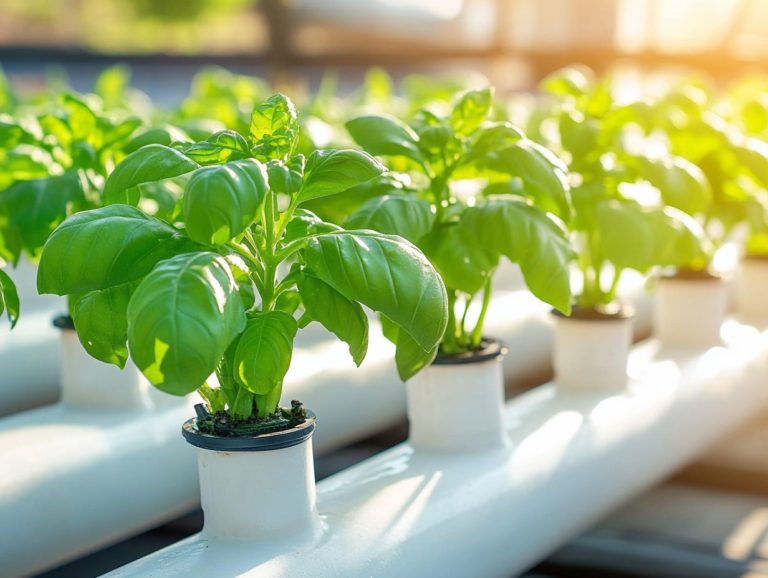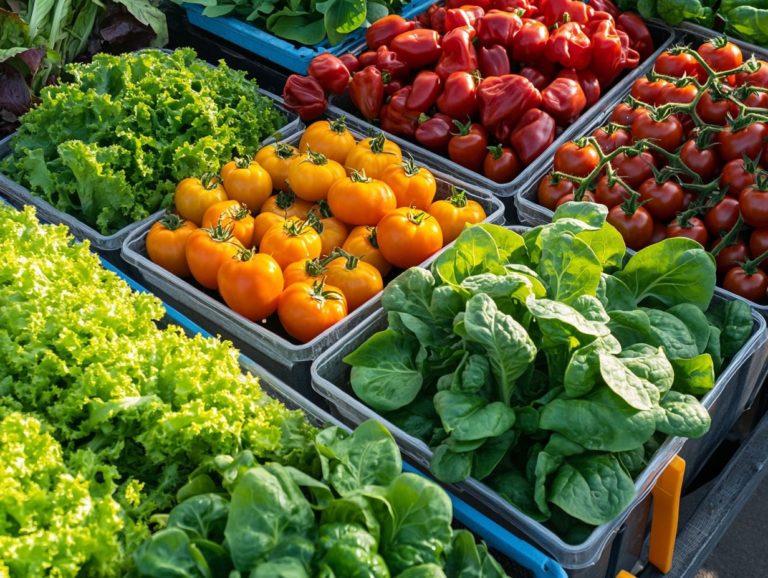“Exploring Different Varieties of Hydroponic Kale”
Hydroponic kale is revolutionizing the way you cultivate this nutrient-rich green. It presents a soil-free alternative that optimizes both space and resources.
This article delves into the myriad benefits of hydroponic kale. You will explore its advantages over conventional growing techniques.
You’ll discover the diverse varieties available. Plus, you ll receive a step-by-step guide for growing and maintaining your crop.
You will also find best practices for harvesting and storage. Troubleshooting tips are included to ensure your kale flourishes.
Prepare to elevate your gardening experience!
Contents
- Key Takeaways:
- What is Hydroponic Kale?
- Benefits of Growing Hydroponic Kale
- Different Varieties of Hydroponic Kale
- Growing and Maintaining Hydroponic Kale
- Harvesting and Using Hydroponic Kale
- Troubleshooting Common Issues
- Frequently Asked Questions
- What are the benefits of exploring different varieties of hydroponic kale?
- What are the most popular varieties of hydroponic kale in urban gardening?
- How do you choose which variety of hydroponic kale to grow?
- What are some unique varieties of hydroponic kale to try?
- Can different varieties of hydroponic kale be grown together?
- Are there any special considerations when growing different varieties of hydroponic kale?
Key Takeaways:

- Experience faster growth and higher yields with hydroponic kale!
- Explore unique varieties of hydroponic kale for different flavors.
- Follow a simple guide to successfully grow hydroponic kale and troubleshoot any issues.
What is Hydroponic Kale?
Hydroponic kale is a remarkable approach to growing kale without soil. Instead, it uses a special water solution that feeds the plants.
This innovative method enables efficient growth in controlled environments such as indoor farms or urban gardens. By employing various systems that deliver essential nutrients, water, and light, hydroponic farming emerges as a more eco-friendly way to grow food.
The absence of soil not only conserves water but also significantly reduces the risk of pests that live in the soil. This makes hydroponic farming an attractive option for those who prioritize health and sustainability, especially urban gardeners seeking to elevate their green-thumb game.
Benefits of Growing Hydroponic Kale
Growing hydroponic kale is not just fun; it’s your ticket to a healthier diet! You can enrich your meals with nutrient-dense greens.
Not only do you enjoy fresh produce, but you also engage in a more eco-friendly cultivation method. This aligns your gardening practices with a greener lifestyle.
Advantages over Traditional Methods
The advantages of growing hydroponic kale are remarkable. You can achieve better water efficiency and create a controlled environment where plants thrive.
Unlike conventional farming, which often relies on unpredictable rainfall and irrigation systems, hydroponic systems can use up to 90% less water. This not only conserves a vital resource but also reduces the risk of soil erosion and contamination.
With hydroponic systems, you can adjust nutrient solutions precisely. This ensures your kale gets the vitamins and minerals it needs for healthy growth.
By regulating light and temperature, you can cultivate kale year-round. This leads to larger yields in less time and promotes sustainable agriculture.
Different Varieties of Hydroponic Kale

You ll discover a remarkable array of hydroponic kale varieties. Each boasts unique characteristics and flavors designed to satisfy a range of culinary preferences.
Among them are the vibrant Curly Kale, the elegantly earthy Red Russian Kale, and the unmistakable Lacinato Kale. Each offers its own delightful twist to your dishes.
Start your hydroponic garden today and taste the difference!
Comparison of Varieties and Their Characteristics
When you delve into the various types of hydroponic kale, you’ll discover that Curly Kale, with its tightly packed leaves and crisp texture, presents a delightful crunch. Red Russian Kale boasts a more delicate flavor and stunning purple-tinged leaves that can elevate any dish.
Lacinato Kale often called Dinosaur Kale has long, dark green leaves that feature a unique bumpy texture, offering a subtly sweeter and earthier taste. Each variety contributes its own charm to your culinary repertoire.
For instance, Curly Kale’s sturdiness makes it perfect for hearty salads or as a robust base for kale chips. Meanwhile, Red Russian Kale shines in light saut s or fresh salads, where its tender leaves can truly take center stage.
Lacinato Kale, with its rich flavor, is superb in soups or blended into smoothies, offering versatility that appeals to both adventurous chefs and health-conscious eaters.
Growing and Maintaining Hydroponic Kale
Growing and maintaining hydroponic kale requires careful attention to a few important factors. You need to select the right growing medium, create optimal lighting conditions, and manage pH levels and nutrient solutions precisely.
Each of these elements is crucial to ensuring your plants thrive and reach their full potential.
Step-by-Step Guide
Creating a thriving hydroponic kale garden starts with selecting the perfect growing medium and setting up a nutrient solution tailored to your plants’ specific needs. From there, ensuring proper lighting and monitoring plant health will set you on the path to success.
- To kick things off, choose a medium like coconut coir or rock wool both excellent for supporting root growth while allowing for exceptional drainage.
- Next, prepare your nutrient solution by balancing essential macro and micronutrients. This ensures your kale gets the fuel it needs to grow effectively.
Once your system is up and running whether you opt for deep water culture, where plants float on water enriched with nutrients, nutrient film technique, or vertical farming it’s time to pay attention to your lighting. Position it correctly to ensure your kale receives the ideal amount of light without risking overheating.
Throughout this journey, keeping a close eye on pH levels and monitoring for pests or diseases will be crucial. This proactive approach will help you troubleshoot any issues that arise, ultimately leading to a bountiful harvest.
Harvesting and Using Hydroponic Kale

Harvesting hydroponic kale is not just a task; it’s a thrilling experience that enhances both flavor and freshness, allowing you to enjoy the full spectrum of its vibrant taste.
By adhering to best practices, you can ensure that these greens maintain their nutrient-rich qualities throughout storage and preparation, elevating your culinary creations to new heights.
Best Practices for Harvesting and Storage
Implementing best practices for harvesting hydroponic kale is essential to keep your greens fresh and nutrient-rich. Focus on techniques that minimize damage to the plants.
When your kale is ready for harvest, use sharp, clean scissors or shears to cut the leaves at the base. This minimizes bruising and stress on the remaining plant, promoting regrowth and maintaining overall vitality.
After harvesting, store your kale in breathable bags within a cool environment to enhance its shelf life significantly. Wrapping the harvested greens in damp paper towels prevents moisture loss while allowing for airflow both crucial for preserving quality and nutritional integrity.
By incorporating these strategic techniques, you can enjoy vibrant, nutrient-dense greens for a longer time, enhancing your overall health and culinary experience.
Troubleshooting Common Issues
Troubleshooting common issues in hydroponic kale cultivation is vital to maintain healthy plants and secure a successful harvest. Whether you re facing infestations from aphids and whiteflies or battling diseases like powdery and downy mildew, addressing these challenges promptly will enhance your gardening success.
Get started with growing your own delicious hydroponic kale today!
Identifying and Addressing Problems
Identifying and addressing problems in hydroponic kale cultivation requires a sharp eye for the symptoms of pests and diseases. Look out for pests like aphids and downy mildew to take timely action and protect your plants.
Start by closely observing your plants every day! Look for signs of distress like discoloration or unusual growth patterns.
Check the undersides of leaves to spot pests such as aphids and spider mites. Diseases like downy mildew may appear as fuzzy yellow patches.
Once you ve identified the issues, implement effective strategies:
- Introduce beneficial insects.
- Apply organic insecticides.
- Adjust conditions like humidity and temperature.
Maintaining a clean growing environment helps prevent issues. Choosing disease-resistant kale varieties can enhance the overall health of your hydroponic system.
Watch our video to discover more tips on growing healthy hydroponic kale!
Frequently Asked Questions

What are the benefits of exploring different varieties of hydroponic kale?
Exploring different varieties of hydroponic kale provides a diverse range of nutrients and flavors. Each variety may offer unique health benefits.
What are the most popular varieties of hydroponic kale in urban gardening?
Popular varieties include curly kale, lacinato kale, and red Russian kale. Each has its distinct flavor and appearance.
How do you choose which variety of hydroponic kale to grow?
When choosing a variety, consider taste, appearance, and nutrient content. Experimenting with different types helps you find your favorites.
What are some unique varieties of hydroponic kale to try?
Try unique varieties like dinosaur kale, scarlet kale, and white Russian kale. They offer different taste profiles and visual appeal.
Can different varieties of hydroponic kale be grown together?
Yes, you can grow different varieties together in the same system. Just keep their growth rates and space needs in mind.
Are there any special considerations when growing different varieties of hydroponic kale?
Each kale variety may have specific growing needs, like temperature and light preferences. Research each one to ensure healthy growth.
Ready to start your hydroponic journey? Choose your favorite kale variety and get growing!






